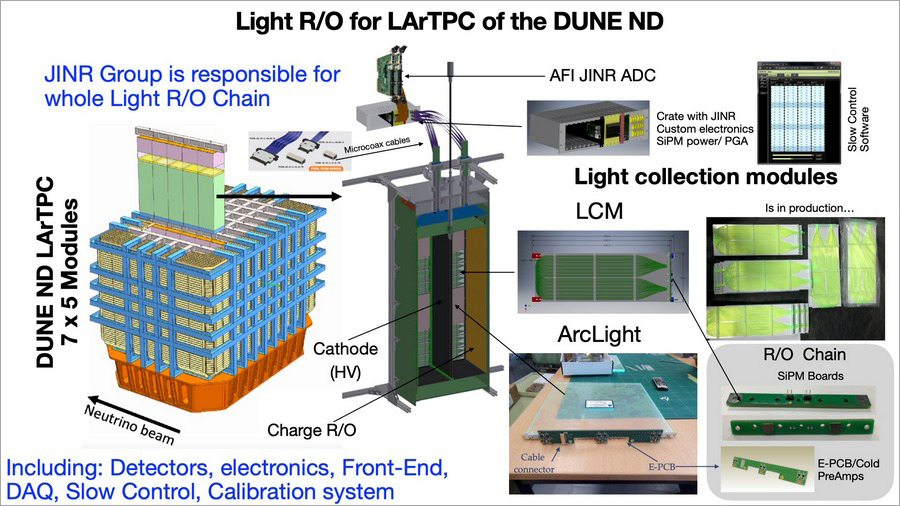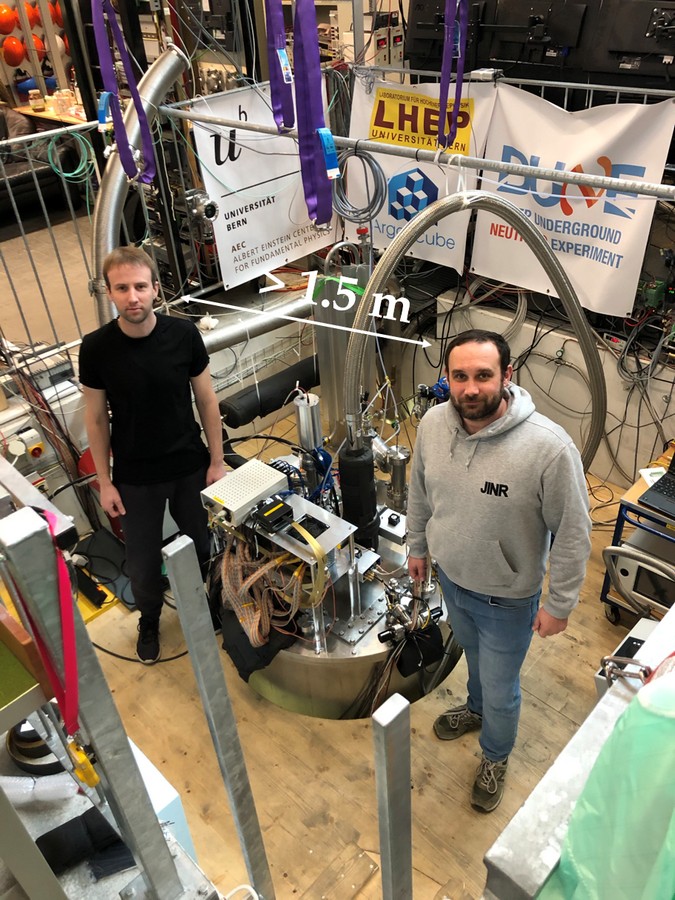On JINR’s participation in DUNE experiment
News, 18 October 2021
At present, the DUNE (Deep Underground Neutrino Experiment) project involves more than 1,000 scientists from different countries of the world. And scientists from the Joint Institute for Nuclear Research are among members of this large international collaboration. Nikolay Anfimov, PhD in Physics and Mathematics, Head of the Sector of Experimental Methodology of the DLNP Experimental Department of Particle Physics (EDPP), one of the leaders of the JINR group involved in the project, talks about the significance of DUNE for the world’s science, about experimental objectives and stages, and the role of the JINR group in this project.
The DUNE experiment, which is scheduled to be launched after 2025, is an accelerator neutrino experiment. Artificial neutrino sources provide scientists with many more opportunities for research, this is why reactor and accelerator neutrino experiments are most efficient in studying oscillations (transformations) of elusive particles. Thus, in the DUNE experiment, the Fermilab experimental complex smashes a beam into the target. Neutrinos produced in interactions will pass first through the Near Detector at Fermilab and then will reach the Far Detector located at Stanford Lab, 1,300 km away.
 Neutrino beam path in the DUNE underground neutrino experiment. Image: Fermilab
Neutrino beam path in the DUNE underground neutrino experiment. Image: Fermilab
A modular time-projection chamber filled with liquid argon (ND-Lar TPC) is intended to be used at the Near Detector. In this regard, scientists are facing a non-trivial task of registering a flash of scintillation light produced in particle interactions in liquid argon.
“To detect the light fluxes like this one, vacuum or silicon photomultipliers are usually used. In this experiment, light has to be detected along a strong electric field whose voltage can reach a kilovolt per centimetre. For this reason, light detection systems should be made of dielectric materials exactly in the part of the chamber where this light is propagating. And JINR undertook to develop such a system,” Nikolay Anfimov, coordinator of the Dubna DUNE group, comments.
 Configuration of the ND-LAr and light readout system
Configuration of the ND-LAr and light readout system
Joint Institute for Nuclear Research in the DUNE Collaboration
“We have long-lasting friendly relations with the University of Bern, since the time of development and operation of another accelerator neutrino experiment, OPERA,” Nikolay Anfimov continues. The neutrino beam from CERN was detected at a distance of 730 km away, at the Gran Sasso Laboratory, Italy. Our colleagues from Bern knew that we are skilled in detector developing. And when the necessity to develop a detector light readout system arose, they contacted JINR. A system like this one requires a huge creative and financial resource, this is the project at the scale of a national laboratory or large research institute. The University of Bern had its own ideas about the configuration of such a system. But we decided to develop our readout system on the basis of fibre optics using the GERDA experience, which was very helpful.
We adopted the experience of our colleagues from the DLNP Experimental Department of Nuclear Spectroscopy and Radiochemistry (EDNSR) who are involved in the GERDA experiment. A similar method of light detection in liquid argon with tetra-phenylbutadiene (TPB) as a wavelength shifter was employed there. TBP coating is applied to green wavelength shifting fibres. Vacuum ultraviolet radiation transforms into a blue light which can be caught by green wavelength fibres and transported further to the area beyond the strong electric field where a standard silicon photomultiplier (SiPM) can be installed.
There is no electric field in GERDA, but we used the idea of our colleagues having adapted it to our objectives and conditions.”
 Light collection modules for the ND-LAr TPC. Left: manufacturing stage, right: design model
Light collection modules for the ND-LAr TPC. Left: manufacturing stage, right: design model
At present, a pilot batch of these light collection modules is ready. The prototype time-projection chamber with all necessary components is assembled at the University of Bern. In March−April 2021, Nikolay Anfimov and Alexander Selyunin, a junior researcher of the Sector of Experimental Methodology of EDPP, were on their working trip to Bern to test the chamber. The newly assembled facility operated really well. “This is a success,” shares his impression Nikolay Anfimov. “Especially, when the project had to be discussed online due to COVID restrictions.”
 Testing the prototype TPC Module0 at the University of Bern (Switzerland). In the photo: Alexander Selyunin and Nikolay Anfimov
Testing the prototype TPC Module0 at the University of Bern (Switzerland). In the photo: Alexander Selyunin and Nikolay Anfimov
Present and future cooperation of the DUNE Collaboration and JINR
Now, prototype detector tests are being performed at the University of Bern. “The detector is operating spectacularly. Particle tracks are clearly seen, and everything can be perfectly joined. Even cosmic rays display super curious physics.”
“After prototype testing, detector mass production will start,” Nikolay Anfimov shares his plans. “We count on cooperation with domestic companies to which we can pass our models for mass production. A batch of a few thousand detectors and eight thousand channels for electronics is to be manufactured.”
There are a lot of requirements for upcoming manufacture, including those for the staff qualification level. The current detector version must be scaled up since the prototype is developed in a scaled-down version. Mass production is to be launched the next year.
“We joined the project in 2017, at the prototype development stage. Afterwards, it became obvious that we are ready to make a well-engineered large-scale detector. It requires a huge number of resources, even at the prototype development stage. Last year, in May, we officially joined the DUNE Collaboration. The project was successfully presented at the session of the JINR Programme Advisory Committee and included in Theme 1099 of the JINR Topical Plan till 2023 as a prototype development project. I hope that by 2023 we will have designed the entire system, and our project will be prolonged within the JINR Topical Plan in this status”, – Nikolay Anfimov noted.